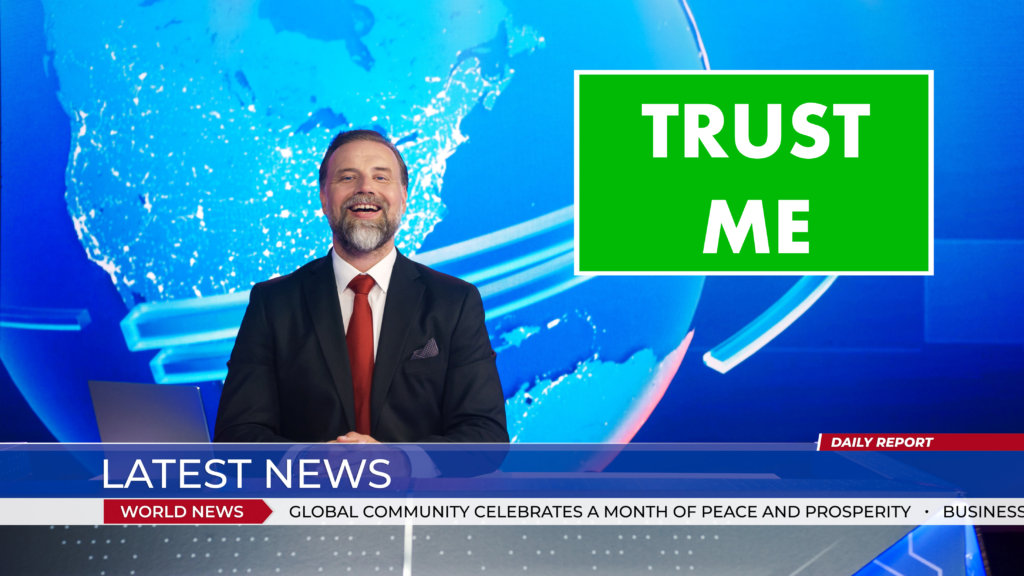
One thing you learn when you’re a consultant, crisscrossing the country for the last several decades:
Everyone thinks their weather is the most unpredictable.
Whether you’re in Boise, Boston, or Boca Raton, the locals are apt to tell you that if you don’t like the weather, wait 20 minutes – and it will change.
With all these peculiarities weather-wise, you’d think consumers would have it in for the meteorologists who make a living trying to predict our weather. But au contraire – the Weather Channel is a trusted source.
In fact, a new Economist/YouGov poll indicates the Weather Channel is far and away the most credible source of news. That’s what a study of 1,500 Americans last month had to say. Interestingly, most of the well-branded, household names in the news game exhibited trust issues, leaving the top spot for the Weather Channel.
Maybe because hurricanes aren’t Republican, cold fronts aren’t Democratic, and heat waves aren’t especially Independent. Weather is decidedly non-partisan, and perhaps that’s what helps TWC thread the needle and come out on top.
If you have no plans this weekend, you can peruse the entire 430 page report. Or you can do what I did, and check out a brief article from YouGov America written by senior data journalist Linsey Sanders who does a nice job summarizing the key findings.
In short, the more political a source is perceived to be, the more trouble it has accruing “trust points” in this survey. The data bars below are created by the percentage point difference between trust and the lack of it:

The Weather Channel storms into the lead, followed impressively by the BBC, then PBS and the Wall Street Journal.
The next tier contains NPR – who can’t be thrilled about its position in this YouGov survey. Note the Washington Post is just five points in the positive range, while the New York Times just ekes out a +3.
There are several outlets “below zero,” including conservative brands OAN, Fox News, and Breitbart. On the other side of the aisle, it’s CNN and MSNBC, each sporting negative trust numbers.
Notably CNN emerges as the most polarizing of the news sources tested. As Sanders reports, two thirds of Democrats trust CNN versus only 11% of GOPers. That 55-point gap is the widest of this group.
While these trust rankers are fascinating, especially to those who consider themselves “news junkies,” the more revealing data in this survey revolves around where Americans get their news – and how this differs by the age of the respondents.
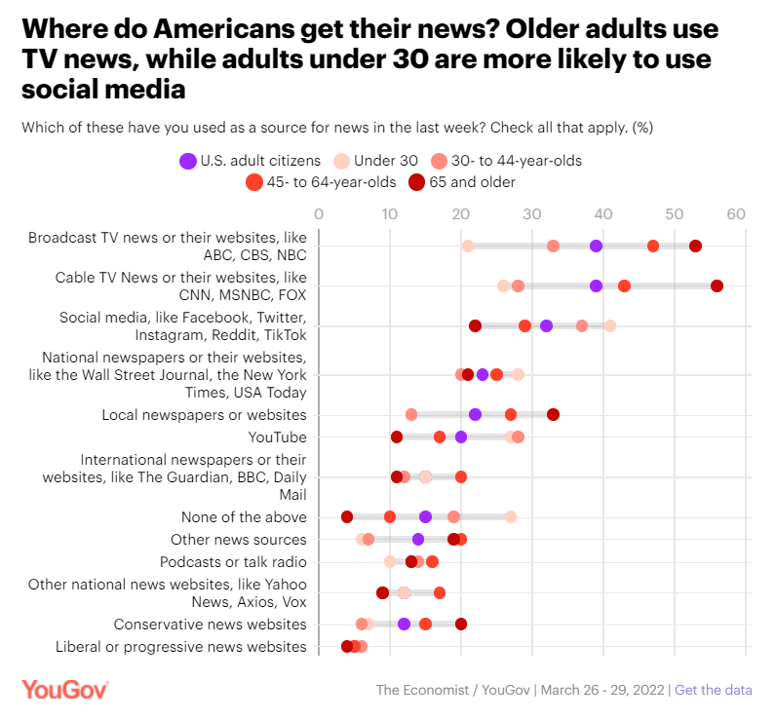
There’s a lot of data here, but if you focus on those under 30 (the light pink dot) versus respondents 45-64 years-old (red dots), you can see the distribution schisms that have formed in the worlds of news and media.
For the aging Boomers – the 45-64s – it’s all about broadcast and cable news outlets. In contrast, those who haven’t yet reached the Big 3-0 consider their go-to news source as social media.
To many news executives – especially those who have plied their craft for decades – knowing that twentysomethings are more likely to have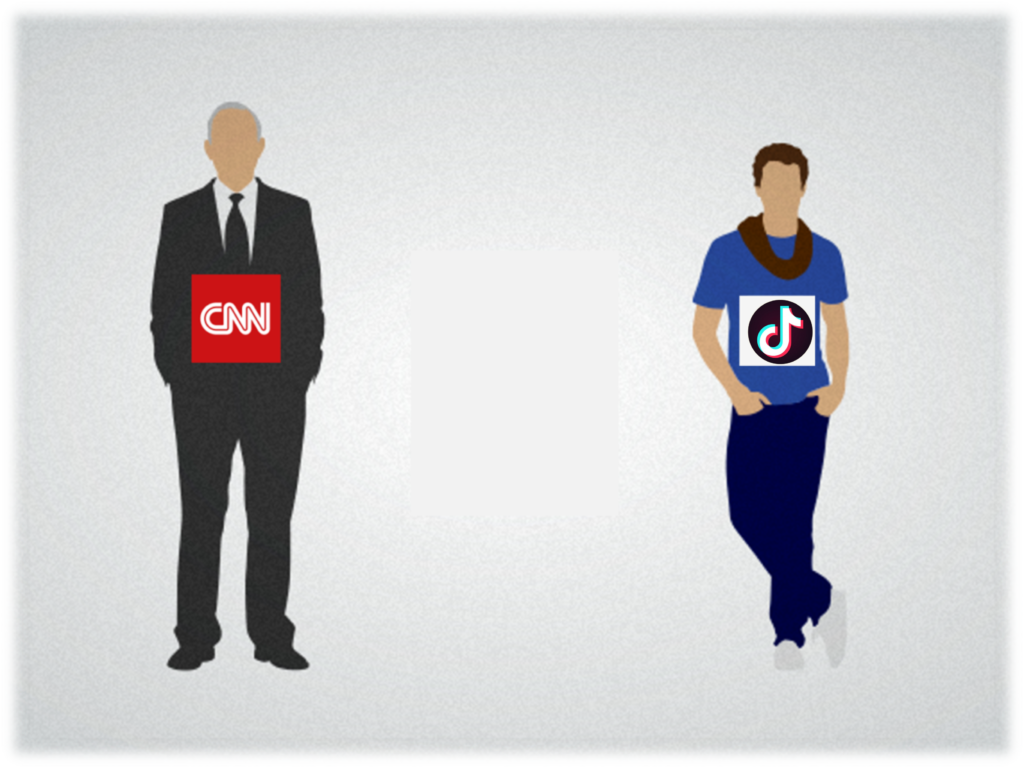 consulted TikTok and Reddit for news over CBS, ABC, or NBC must be profoundly painful. But this is nothing new. We’ve seen the same patterns surface in the public radio research and consulting work we’ve done.
consulted TikTok and Reddit for news over CBS, ABC, or NBC must be profoundly painful. But this is nothing new. We’ve seen the same patterns surface in the public radio research and consulting work we’ve done.
Sadly, the Economist/YouGov researchers made an epic faux pas in grouping together “podcasts” with (stated as “or”) “talk radio.” The dots are clustered close to each other, an indication that respondents likely struggled with trying to figure out which platform the researchers were talking about.
But this leads to a related but equally salient question – “Where’s radio?”
The omission of broadcast radio in studies like this happens with great frequency. But it also may speak to just how little news – with a capital “N” – actually is part of most radio stations’ content menus. Once you get beyond NPR News stations, and the All News station in the nation’s biggest markets, news doesn’t make up a big slice of most stations’ content pie. Nor should it.
Again, public radio is an exception here. But the “Trust In Media” study excludes NPR. Fortunately, our Public Radio Techsurveys don’t. Public radio operators understand the differences between content and distribution. Yes, most public radio stations have strong news products that provide perspective, storytelling, and relevance. Where managers often struggle is in the determination of the best distribution outlets that service an increasingly diverse audience.
Meeting the listeners where they are is becoming increasingly challenging. Determining these platforms, and then delivering quality, custom content on them is expensive, time-consuming, and challenging, particularly for staffs loaded with news veterans.
![]() As the Economist/YouGov survey points out, it’s often a tale of two audiences. Yes, there’s the political schism, apparent to anyone paying attention anytime you access a news story. But the “generation gap” is the other important dynamic.
As the Economist/YouGov survey points out, it’s often a tale of two audiences. Yes, there’s the political schism, apparent to anyone paying attention anytime you access a news story. But the “generation gap” is the other important dynamic.
As a content creator in radio, what is the role of news? Obviously in public radio, it’s the bread and butter vertical for most stations and organizations.
But what about on the commercial radio side of the street? Outside of the big news stations in larger markets – WSB, KSL, WTOP, WCBS, and a couple dozen others – how important is news and information in the big picture?
When we isolate our respondents in Techsurvey 2022 who enter the survey via a music station, fewer than three in ten tell us that news and information are key drivers for why they listen to broadcast radio. Given the trends we’re seeing, we might expect that appetite to diminish with each passing year. News ranks near the bottom of listener priorities for music stations:
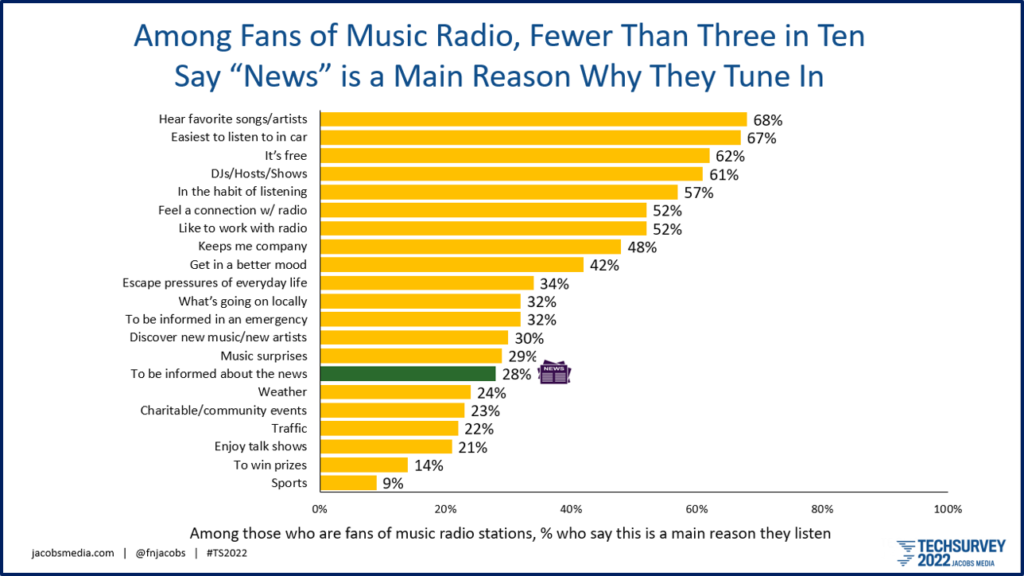
Outside of carrying sponsorship ads, programmers of music stations might be wise to evaluate their news diets, and question why they are still delivering newscasts in the conventional way. Perhaps news should be selectively filtered through the bizarre lens of personalities, quipping on today’s headlines in much the same way SNL has used “Weekend Update” since their very first show.
Consumer priorities are changing – the Economist/YouGov research confirms this. (There’s a lot more data worth looking at, especially if you work for a news outlet.)
For outlets that make a living at delivering the news, the study is a clarion call to reassess their products, delivery, and personnel.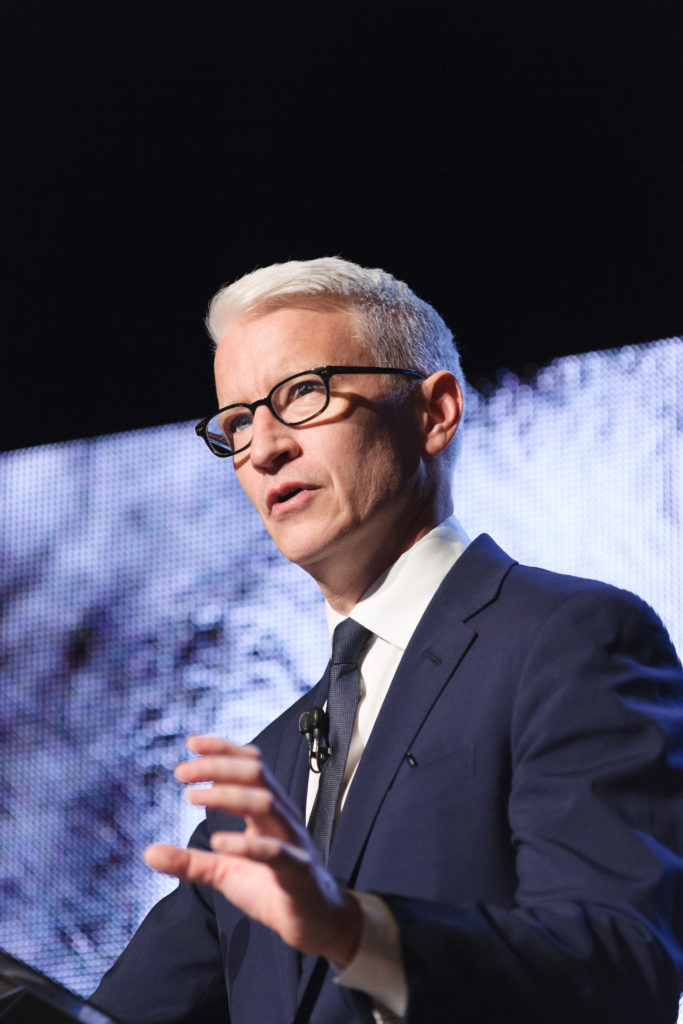
That last category is an important one. Sometimes, the power of a great personality can transcend – or at least diminish – the tarnished image of a news brand. Take CNN, for example. There’s little good news for them in the Economist/YouGov study. And the reported failure of their subscription service – CNN Plus – to get any traction may be due in large part to the parent brand’s reputational problems.
The poll tested a series of news personalities, and at the top of the list is a familiar name: CNN’s Anderson Cooper. Of those familiar with him, 44% say they trust Cooper, placing him ahead of ABC’s David Muir (40%), and Fox News’ Bret Baier. Cooper may benefit from his role on “60 Minutes,” but the fact is, he anchors prime time real estate on the most bipolar network, CNN. Still, these rankings reek of political divisiveness:

Still, personality matters, whether it’s behind the mic or in front of the camera.
Same as it ever was.
- Why “Dance With Those Who Brung You” Should Be Radio’s Operating Philosophy In 2025 - April 29, 2025
- The Exponential Value of Nurturing Radio Superfans - April 28, 2025
- What To Do If Your Radio Station Goes Through A Midlife Crisis - April 25, 2025




Boy, is there a lot to unpack here, Fred. First, anyone who is not frightened by evidence that the young get their news and information mostly from “social media” just isn’t paying attention. The only consolation that occurs to me is remembering that, on many topics, I had my own case of cranial rectumitis when I was a member of that demo. Glass houses, stones …
Secondly, as to the seemingly low trust-point scores of the various channels in the first graphic, I think less chagrin is in order than you suggest. All of us have a fair idea of the difference between true journalism (in whatever medium) and advocacy. That the scores for most of the former are in the plus range at all is to me somewhat reassuring, since it means more people in the sample have trust than don’t. One hopes these are the people who go to the polls. Similarly, I am glad to see the reported relative distrust in the latter, because it suggests the audience can taste the large grain of salt that accompanies what’s being flogged.
Finally, you’re on target with your observation that radio has work to do–not only on the talk radio v podcast commingling but also on the larger matter of what I’ll call “discrete presence on the radar screen.” I get my own news and information primarily from non-broadcast sources, but I find it chastening to see the medium I love almost entirely ignored by the researchers who designed and analysed the survey. I doubt it was deliberate; asking about radio separately probably just didn’t occur to them. And that’s where I feel gut-punched.
Thank you for this thoughtful comment, John. I think the social media piece isn’t as alarming as it sounds. While social media IS the go-to for younger consumers, much of what they get there is articles many of which are from legitimate sources. Big news brands need to hone their social media skills to develop better presence on these plaforms.
On your second point, I respectfully question your presence that most can make the distinction between journalism and propaganda. I think many people aren’t educated enough to tell the difference. As for who ends up voting, you may be right about that.
And finally your third point annoys the hell out of me largely because it happens so often. Radio gets ganged together with a platform dissimilar from its essence – such as pairing it with podcasting – similar to how the Economist/YouGov researchers screwed up. It underscores the lack of respect for radio that so many organizations carry. Yes, it’s a gut punch.
Radio got out of the news business a long time ago and that was probably a good decision and should, as you suggest, drop news entirely except on all news outlets.
This survey sheds more light on prevailing misinformation and polarization than anything I’ve seen yet. I don’t share your lack of alarm regarding social media as a news source. Social media feeds are designed to trigger emotion, clicks and sharing, not to inform. I doubt that what people would say they want in news sources is close to what they actually get from social media.
But I’m just as bothered by the fact that so many 45+ people use TV as their main news source. When the major news sources’ goals are eyeballs or clicks/shares, its no wonder that people are so misinformed. For the most part, people seem to have gotten cable network bias correctly – right down to very few trusting Alex Jones, but apparently just head for their corners anyway. When most people’s news sources are designed to reinforce already held beliefs, trigger raw emotion or both, a growing, polarizing gap between facts and beliefs is inevitable.
FWIW, there is probably more fact on cable news than The Weather Channel.
It’s not that I’m not alarmed, it’s just that I’ve accepted the reality that for these generations, it is what it is. Their news appetites are different that ours. The “mainstream media” hasn’t figured out how to talk to them. I’m not saying it’s good. I am say it IS.
As for TV being a main source, the alternatives aren’t what they used to be. Whereas people in our generation were avid newspaper and magazine readers, those ships have sailed.
I was surprised The Weather Channel did so well, a statement more about cable news that TWC doing a great job. Thanks, Bob.
i was referring to the accuracy of TWC forecasts and weather forecasts in general
This is an excellent report. Dr. Jacobs. Perhaps you know that a full-time weather radio station 1280am made a brief appearance in the TC is the early 1970s. They lost a bundle of money. I think it lasted less than a year.
I did not know that, Ken. Even in an active weather market like yours, weather is not a full-time strategy. Thanks for the kind words.